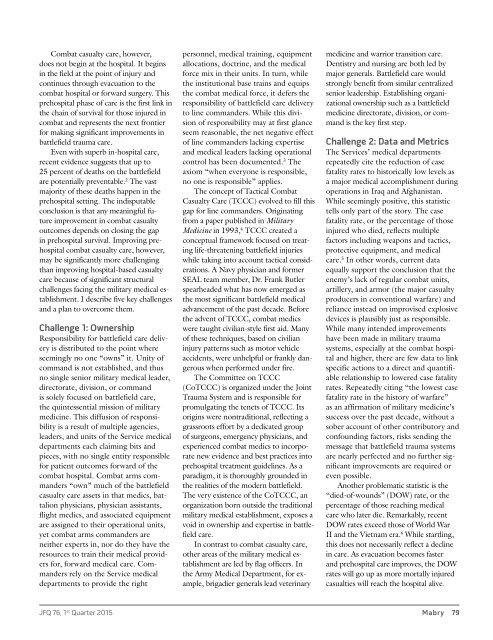jfq-76
jfq-76
jfq-76
You also want an ePaper? Increase the reach of your titles
YUMPU automatically turns print PDFs into web optimized ePapers that Google loves.
Combat casualty care, however,<br />
does not begin at the hospital. It begins<br />
in the field at the point of injury and<br />
continues through evacuation to the<br />
combat hospital or forward surgery. This<br />
prehospital phase of care is the first link in<br />
the chain of survival for those injured in<br />
combat and represents the next frontier<br />
for making significant improvements in<br />
battlefield trauma care.<br />
Even with superb in-hospital care,<br />
recent evidence suggests that up to<br />
25 percent of deaths on the battlefield<br />
are potentially preventable. 2 The vast<br />
majority of these deaths happen in the<br />
prehospital setting. The indisputable<br />
conclusion is that any meaningful future<br />
improvement in combat casualty<br />
outcomes depends on closing the gap<br />
in prehospital survival. Improving prehospital<br />
combat casualty care, however,<br />
may be significantly more challenging<br />
than improving hospital-based casualty<br />
care because of significant structural<br />
challenges facing the military medical establishment.<br />
I describe five key challenges<br />
and a plan to overcome them.<br />
Challenge 1: Ownership<br />
Responsibility for battlefield care delivery<br />
is distributed to the point where<br />
seemingly no one “owns” it. Unity of<br />
command is not established, and thus<br />
no single senior military medical leader,<br />
directorate, division, or command<br />
is solely focused on battlefield care,<br />
the quintessential mission of military<br />
medicine. This diffusion of responsibility<br />
is a result of multiple agencies,<br />
leaders, and units of the Service medical<br />
departments each claiming bits and<br />
pieces, with no single entity responsible<br />
for patient outcomes forward of the<br />
combat hospital. Combat arms commanders<br />
“own” much of the battlefield<br />
casualty care assets in that medics, battalion<br />
physicians, physician assistants,<br />
flight medics, and associated equipment<br />
are assigned to their operational units,<br />
yet combat arms commanders are<br />
neither experts in, nor do they have the<br />
resources to train their medical providers<br />
for, forward medical care. Commanders<br />
rely on the Service medical<br />
departments to provide the right<br />
personnel, medical training, equipment<br />
allocations, doctrine, and the medical<br />
force mix in their units. In turn, while<br />
the institutional base trains and equips<br />
the combat medical force, it defers the<br />
responsibility of battlefield care delivery<br />
to line commanders. While this division<br />
of responsibility may at first glance<br />
seem reasonable, the net negative effect<br />
of line commanders lacking expertise<br />
and medical leaders lacking operational<br />
control has been documented. 3 The<br />
axiom “when everyone is responsible,<br />
no one is responsible” applies.<br />
The concept of Tactical Combat<br />
Casualty Care (TCCC) evolved to fill this<br />
gap for line commanders. Originating<br />
from a paper published in Military<br />
Medicine in 1993, 4 TCCC created a<br />
conceptual framework focused on treating<br />
life-threatening battlefield injuries<br />
while taking into account tactical considerations.<br />
A Navy physician and former<br />
SEAL team member, Dr. Frank Butler<br />
spearheaded what has now emerged as<br />
the most significant battlefield medical<br />
advancement of the past decade. Before<br />
the advent of TCCC, combat medics<br />
were taught civilian-style first aid. Many<br />
of these techniques, based on civilian<br />
injury patterns such as motor vehicle<br />
accidents, were unhelpful or frankly dangerous<br />
when performed under fire.<br />
The Committee on TCCC<br />
(CoTCCC) is organized under the Joint<br />
Trauma System and is responsible for<br />
promulgating the tenets of TCCC. Its<br />
origins were nontraditional, reflecting a<br />
grassroots effort by a dedicated group<br />
of surgeons, emergency physicians, and<br />
experienced combat medics to incorporate<br />
new evidence and best practices into<br />
prehospital treatment guidelines. As a<br />
paradigm, it is thoroughly grounded in<br />
the realities of the modern battlefield.<br />
The very existence of the CoTCCC, an<br />
organization born outside the traditional<br />
military medical establishment, exposes a<br />
void in ownership and expertise in battlefield<br />
care.<br />
In contrast to combat casualty care,<br />
other areas of the military medical establishment<br />
are led by flag officers. In<br />
the Army Medical Department, for example,<br />
brigadier generals lead veterinary<br />
medicine and warrior transition care.<br />
Dentistry and nursing are both led by<br />
major generals. Battlefield care would<br />
strongly benefit from similar centralized<br />
senior leadership. Establishing organizational<br />
ownership such as a battlefield<br />
medicine directorate, division, or command<br />
is the key first step.<br />
Challenge 2: Data and Metrics<br />
The Services’ medical departments<br />
repeatedly cite the reduction of case<br />
fatality rates to historically low levels as<br />
a major medical accomplishment during<br />
operations in Iraq and Afghanistan.<br />
While seemingly positive, this statistic<br />
tells only part of the story. The case<br />
fatality rate, or the percentage of those<br />
injured who died, reflects multiple<br />
factors including weapons and tactics,<br />
protective equipment, and medical<br />
care. 5 In other words, current data<br />
equally support the conclusion that the<br />
enemy’s lack of regular combat units,<br />
artillery, and armor (the major casualty<br />
producers in conventional warfare) and<br />
reliance instead on improvised explosive<br />
devices is plausibly just as responsible.<br />
While many intended improvements<br />
have been made in military trauma<br />
systems, especially at the combat hospital<br />
and higher, there are few data to link<br />
specific actions to a direct and quantifiable<br />
relationship to lowered case fatality<br />
rates. Repeatedly citing “the lowest case<br />
fatality rate in the history of warfare”<br />
as an affirmation of military medicine’s<br />
success over the past decade, without a<br />
sober account of other contributory and<br />
confounding factors, risks sending the<br />
message that battlefield trauma systems<br />
are nearly perfected and no further significant<br />
improvements are required or<br />
even possible.<br />
Another problematic statistic is the<br />
“died-of-wounds” (DOW) rate, or the<br />
percentage of those reaching medical<br />
care who later die. Remarkably, recent<br />
DOW rates exceed those of World War<br />
II and the Vietnam era. 6 While startling,<br />
this does not necessarily reflect a decline<br />
in care. As evacuation becomes faster<br />
and prehospital care improves, the DOW<br />
rates will go up as more mortally injured<br />
casualties will reach the hospital alive.<br />
JFQ <strong>76</strong>, 1 st Quarter 2015 Mabry 79




